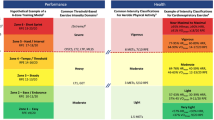Abstract
Purpose
Heart rate recovery (HRR) after treadmill exercise testing is an index of cardiac autonomic activity in non-disabled persons, but it is unknown if this is also the case in individuals with spinal cord injury (SCI). We investigated the relationship between HRR after maximal arm exercise testing and resting autonomic activity in persons with paraplegia.
Methods
A total of 17 (male n = 9, female n = 8) active individuals with paraplegia (injury below T6) were included in the study. Frequency domain analyses of resting heart rate variability were obtained and participants completed a maximal arm exercise test. HRR was calculated as the difference between peak heart rate during the test and heart rate 1 min (HRR1) and 2 (HRR2) min after cessation of exercise.
Results
HRR 1 and HRR 2 were statistically significantly correlated with high-frequency (HF) power (r = 0.46, p < 0.05 and r = 0.47, p < 0.05) and the LF/HF ratio (r = −0.49, p < 0.05 and r = −0.50, p < 0.05). After adjusting for age, peak heart rate and peak oxygen uptake, HRR 2 was still significantly associated with HF power (r = 0.50, p < 0.05) and the LF/HF ratio (r = −0.58, p < 0.05).
Conclusions
These findings indicate that HRR after maximal arm exercise testing is associated with resting cardiac autonomic activity in persons with paraplegia. This would suggest that HRR after maximal arm exercise testing can be used as an index of autonomic function in this population.


Similar content being viewed by others
References
Cole CR, Blackstone EH, Pashkow FJ, Snader CE, Lauer MS (1993) Heart-rate recovery immediately after exercise as a predictor of mortality. N Engl J Med 341:1351–1357
Myers J, Lee M, Kiratli J (2007) Cardiovascular disease in spinal cord injury: an overview of prevalence, risk, evaluation, and management. Am J Phys Med Rehabil 86:142–152
Krassioukov A, Claydon VE (2006) The clinical problems in cardiovascular control following spinal cord injury: an overview. Prog Brain Res 152:223–229
Garshick E, Kelley A, Cohen SA, Garrison A, Tun CG, Gagnon D, Brown R (2005) A prospective assessment of mortality in chronic spinal cord injury. Spinal Cord 43:408–416
Imai K, Sato H, Hori M, Kusuoka H, Ozaki H, Yokoyama H, Takeda H, Inoue M, Kamada T (1994) Vagally mediated heart rate recovery after exercise is accelerated in athletes but blunted in patients with chronic heart failure. J Am Coll Cardiol 24:1529–1535
Task Force of the European Society of Cardiology and the North American Society of Pacing and Electrophysiology (1996) Heart rate variability: standards of measurement, physiological interpretation and clinical use. Circulation 93:1043–1065
Ditor DS, Kamath MV, Macdonald MJ, Bugaresti J, McCartney N, Hicks AL (2005) Reproducibility of heart rate variability and blood pressure variability in individuals with spinal cord injury. Clin Auton Res 15:387–393
Haisma JA, van der Woude LH, Stam HJ, Bergen MP, Sluis TA, Bussmann JB (2006) Physical capacity in wheelchair-dependent persons with a spinal cord injury: a critical review of the literature. Spinal Cord 44:642–652
Buchheit M, Gindre C (2006) Cardiac parasympathetic regulation: respective associations with cardiorespiratory fitness and training load. Am J Physiol Heart Circ Physiol 291:H451–H458
Heffernan KS, Fahs CA, Shinsako KK, Jae SY, Fernhall B (2007) Heart rate recovery and heart rate complexity following resistance exercise training and detraining in young men. Am J Physiol Heart Circ Physiol 293:H3180–H3186
Buchheit M, Papelier Y, Laursen PB, Ahmaidi S (2007) Noninvasive assessment of cardiac parasympathetic function: postexercise heart rate recovery or heart rate variability? Am J Physiol Heart Circ Physiol 293:H8–H10
Schwartz PJ (1998) The autonomic nervous system and sudden death. Eur Heart J 19(suppl):72–80
Freeman JV, Dewey FE, Hadley DM, Myers J, Froelicher VF (2006) Autonomic nervous system interaction with the cardiovascular system during exercise. Prog Cardiovasc Dis 48:342–362
Collins HL, Rodenbaugh DW, DiCarlo SE (2006) Spinal cord injury alters cardiac electrophysiology and increases the susceptibility to ventricular arrhythmias. Prog Brain Res 152:275–288
Evrengul H, Tanriverdi H, Kose S, Amasyali B, Kilic A, Celik T, Turhan H (2006) The relationship between heart rate recovery and heart rate variability in coronary artery disease. Ann Noninvasive Electrocardiol 11:154–162
Ohuchi H, Suzuki H, Yasuda K, Arakaki Y, Echigo S, Kamiya T (2000) Heart rate recovery after exercise and cardiac autonomic nervous activity in children. Pediatr Res 47:329–335
Wecht JM, Marsico R, Weir JP, Spungen AM, Bauman WA, DeMeersman RE (2006) Autonomic recovery from peak arm exercise in fit and unfit individuals with paraplegia. Med Sci Sports Exerc 38:1223–1228
Conflict of interest
None.
Author information
Authors and Affiliations
Corresponding author
Rights and permissions
About this article
Cite this article
Jae, S.Y., Heffernan, K.S., Lee, M. et al. Relation of heart rate recovery to heart rate variability in persons with paraplegia. Clin Auton Res 21, 111–116 (2011). https://doi.org/10.1007/s10286-010-0096-0
Received:
Accepted:
Published:
Issue Date:
DOI: https://doi.org/10.1007/s10286-010-0096-0




